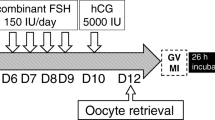Abstract
Purpose
Binovular follicles including a pair of conjoined oocytes within a common zona pellucida or their fusion in the zonal region gained some attentions due to its possible role in dizygotic twins. Although some cases in the literature been reported in which two conjoined oocytes arising from binovular follicles were mature, and injected with two separated sperm, no available evidence reported for dizygotic twin pregnancies.
Methods
A case report of a 37-year-old female patient underwent embryo transfer cycle whereby a pair of conjoined blastocysts after ICSI of a pair of conjoined oocytes was transferred.
Results
The β-hCG level was positive 15 days after embryo transfer. The subsequent pregnancy scan revealed a dizygotic pregnancy. The woman gave birth to two healthy boys in the mid of 38 weeks of gestation by cesarean section.
Conclusions
Given the insufficient evidence on how to handle conjoined oocytes, this report acknowledges the first occurrence of dizygotic twin delivery resulted from transfer of a pair of conjoined blastocysts after ICSI of a pair of conjoined oocytes. This also confirms that we should be extremely conservative in discarding any mature oocyte without sufficient data about its useless future to result in a healthy baby.


Similar content being viewed by others
References
Hall JG. Twinning. Lancet. 2003;362:735–43.
Hoekstra C, Zhao ZZ, Lambalk CB, Willemsen G, Martin NG, Boomsma DI, et al. Dizygotic twinning. Hum Reprod Update. 2008;14(1):37–47.
Bensdorp AJ, Hukkelhoven CW, van der Veen F, Mol BW, Lambalk CB, van Wely M. Dizygotic twin pregnancies after medically assisted reproduction and after natural conception: maternal and perinatal outcomes. Fertil Steril. 2016;106(2):371–7.
Ben-Rafael Z, Mastroianni L Jr, Kopf GS. In vitro fertilization and cleavage of a single egg from a binovular follicle containing two individual eggs surrounded by a single zona pellucida. Fertil Steril. 1987;47(4):707–9.
Fishel S, Kaufman MH, Jackson P, Webster J, Faratian B. Recovery of two human oocytes surrounded by a single zona pellucida. Fertil Steril. 1989;52(2):325–7.
Hartshorne GM, Blayney M, Dyson H, Elder K. In vitro fertilization and development of one of two human oocytes with fused zonae pellucidae: case report. Fertil Steril. 1990;54(5):947–9.
Zeilmaker GH, Alberda AT, van Gent I. Fertilization and cleavage of oocytes from a binovular human ovarian follicle: a possible cause of dizygotic twinning and chimerism. Fertil Steril. 1983;40(6):841–3.
Rosenbusch B. The potential significance of binovular follicles and binucleate giant oocytes for the development of genetic abnormalities. J Genet. 2012;91(3):397–404.
Reynaud K, Halter S, Tahir Z, Thoumire S, Chebrout M, Chastant-Maillard S. Polyovular follicles. Gynecol Obstet Fertil. 2010;38:395–7 (in French).
Vicdan K, Işik AZ, Daðli HG, Kaba A, Kişnişçi H. Fertilization and development of a blastocyst-stage embryo after selective intracytoplasmic sperm injection of a mature oocyte from a binovular zona pellucida: a case report. J Assist Reprod Genet. 1999;16:355–7.
Telfer E, Gosden RG. A quantitative cytological study of polyovular follicles in mammalian ovaries with particular reference to the domestic bitch (Canis familiaris). J Reprod Fertil. 1987;81:137–47.
Rosenbusch B, Hancke K. Conjoined human oocytes observed during assisted reproduction: description of three cases and review of the literature. Romanian J Morphol Embryol. 2012;53(1):189–92.
Yano K, Hashida N, Kubo T, Ohashi I, Koizumi A, Kageura R, et al. Repeated collection of conjoined oocytes from a patient with polycystic ovary syndrome, resulting in one successful live birth from frozen thawed blastocyst transfer: a case report. J Assist Reprod Genet. 2017;34(11):1547–52.
Cummins L, Koch J, Kilani S. Live birth resulting from a conjoined oocyte confirmed as euploid using array CGH: a case report. Reprod BioMed Online. 2016;32(1):62–5.
Gardner DK, Lane M, Stevens J, Schlenker T, Schoolcraft WB. Blastocyst score affects implantation and pregnancy outcome: towards a single blastocyst transfer. Fertil Steril. 2000;73:1155–8.
Fishel S, Kaufman MH, Jackson P, Webster J, Faratian B. Recovery of two humanoocytes surrounded by a single zona pellucida. Fertil Steril. 1989;52:325–7.
Tanaka A, Nakamura H, Kumasawa K, Tsutsui T, Furuya K, Kim N, et al. A case report of conjoined oocytes with independent zona pellucida from polycystic ovary syndrome. J Gynaecol Obstet. 2016;4(5):25–9.
Ron-El R, Nachum H, Golan A, Herman A, Yigal S, Caspi E. Binovular human ovarian follicles associated with in vitro fertilization: incidence and outcome. Fertil Steril. 1990;54:869–72.
Turkalj B, Kotanidis L, Nikolettos N. Binovular complexes after ovarian stimulation. A report of four cases. Hippokratia. 2013;17(2):169–70.
Asimakopoulos B, Kotanidis L, Nikolettos N. Binovular complexes after ovarian stimulation. A report of four cases. Hippokratia. 2013;17:169–70.
Author information
Authors and Affiliations
Corresponding author
Additional information
Publisher’s note
Springer Nature remains neutral with regard to jurisdictional claims in published maps and institutional affiliations.
Rights and permissions
About this article
Cite this article
Magdi, Y. Dizygotic twin from conjoined oocytes: a case report. J Assist Reprod Genet 37, 1367–1370 (2020). https://doi.org/10.1007/s10815-020-01772-z
Received:
Accepted:
Published:
Issue Date:
DOI: https://doi.org/10.1007/s10815-020-01772-z




